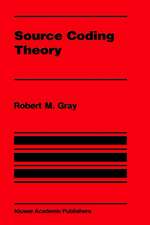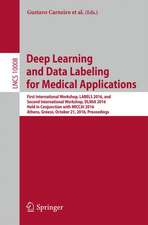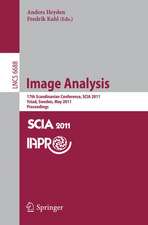Image Segmentation and Compression Using Hidden Markov Models: The Springer International Series in Engineering and Computer Science, cartea 571
Autor Jia Li, Robert M. Grayen Limba Engleză Paperback – 3 oct 2012
Image segmentation is a process for dividing an image into its constituent parts. For block-based segmentation using statistical classification, an image is divided into blocks and a feature vector is formed for each block by grouping statistics of its pixel intensities. Conventional block-based segmentation algorithms classify each block separately, assuming independence of feature vectors.
Image Segmentation and Compression Using Hidden Markov Models presents a new algorithm that models the statistical dependence among image blocks by two dimensional hidden Markov models (HMMs). Formulas for estimating the model according to the maximum likelihood criterion are derived from the EM algorithm. To segment an image, optimal classes are searched jointly for all the blocks by the maximum a posteriori (MAP) rule. The 2-D HMM is extended to multiresolution so that more context information is exploited in classification and fast progressive segmentation schemes can be formed naturally.
The second issue addressed in the book is the design of joint compression and classification systems using the 2-D HMM and vector quantization. A classifier designed with the side goal of good compression often outperforms one aimed solely at classification because overfitting to training data is suppressed by vector quantization.
Image Segmentation and Compression Using Hidden Markov Models is an essential reference source for researchers and engineers working in statistical signal processing or image processing, especially those who are interested in hidden Markov models. It is also of value to those working on statistical modeling.
| Toate formatele și edițiile | Preț | Express |
|---|---|---|
| Paperback (1) | 980.22 lei 6-8 săpt. | |
| Springer Us – 3 oct 2012 | 980.22 lei 6-8 săpt. | |
| Hardback (1) | 986.34 lei 6-8 săpt. | |
| Springer Us – 31 aug 2000 | 986.34 lei 6-8 săpt. |
Din seria The Springer International Series in Engineering and Computer Science
- 24%
 Preț: 1041.98 lei
Preț: 1041.98 lei - 20%
 Preț: 643.50 lei
Preț: 643.50 lei - 18%
 Preț: 1225.62 lei
Preț: 1225.62 lei - 18%
 Preț: 965.02 lei
Preț: 965.02 lei - 20%
 Preț: 646.12 lei
Preț: 646.12 lei - 18%
 Preț: 948.79 lei
Preț: 948.79 lei - 20%
 Preț: 646.62 lei
Preț: 646.62 lei - 15%
 Preț: 637.46 lei
Preț: 637.46 lei - 20%
 Preț: 643.83 lei
Preț: 643.83 lei - 18%
 Preț: 949.23 lei
Preț: 949.23 lei - 20%
 Preț: 644.48 lei
Preț: 644.48 lei - 20%
 Preț: 994.92 lei
Preț: 994.92 lei - 20%
 Preț: 645.97 lei
Preț: 645.97 lei - 18%
 Preț: 946.87 lei
Preț: 946.87 lei - 20%
 Preț: 995.57 lei
Preț: 995.57 lei - 18%
 Preț: 956.99 lei
Preț: 956.99 lei - 20%
 Preț: 644.98 lei
Preț: 644.98 lei - 15%
 Preț: 649.54 lei
Preț: 649.54 lei - 18%
 Preț: 950.21 lei
Preț: 950.21 lei - 18%
 Preț: 1221.38 lei
Preț: 1221.38 lei - 18%
 Preț: 957.62 lei
Preț: 957.62 lei - 15%
 Preț: 643.99 lei
Preț: 643.99 lei - 18%
 Preț: 948.47 lei
Preț: 948.47 lei - 18%
 Preț: 947.35 lei
Preț: 947.35 lei - 20%
 Preț: 1284.65 lei
Preț: 1284.65 lei - 20%
 Preț: 1628.31 lei
Preț: 1628.31 lei - 20%
 Preț: 1285.78 lei
Preț: 1285.78 lei
Preț: 980.22 lei
Preț vechi: 1225.28 lei
-20% Nou
Puncte Express: 1470
Preț estimativ în valută:
187.59€ • 195.12$ • 154.87£
187.59€ • 195.12$ • 154.87£
Carte tipărită la comandă
Livrare economică 14-28 aprilie
Preluare comenzi: 021 569.72.76
Specificații
ISBN-13: 9781461370277
ISBN-10: 1461370272
Pagini: 160
Ilustrații: XIII, 141 p.
Dimensiuni: 155 x 235 x 8 mm
Greutate: 0.23 kg
Ediția:Softcover reprint of the original 1st ed. 2000
Editura: Springer Us
Colecția Springer
Seria The Springer International Series in Engineering and Computer Science
Locul publicării:New York, NY, United States
ISBN-10: 1461370272
Pagini: 160
Ilustrații: XIII, 141 p.
Dimensiuni: 155 x 235 x 8 mm
Greutate: 0.23 kg
Ediția:Softcover reprint of the original 1st ed. 2000
Editura: Springer Us
Colecția Springer
Seria The Springer International Series in Engineering and Computer Science
Locul publicării:New York, NY, United States
Public țintă
ResearchCuprins
1. Introduction.- 1.1 Image Segmentation and Compression.- 1.2 Overview.- 2. Statistical Classification.- 2.1 Bayes Optimal Classification.- 2.2 Algorithms.- 2.3 Markov Random Fields.- 2.4 Markov Mesh.- 2.5 Multiresolution Image Classification.- 3. Vector Quantization.- 3.1 Introduction.- 3.2 Transform VQ.- 3.3 VQ as a Clustering Method.- 3.4 Bayes Vector Quantization.- 4 Two Dimensional Hidden Markov Model.- 4.1 Background.- 4.2 Viterbi Training.- 4.3 Previous Work on 2-D HMM.- 4.4 Outline of the Algorithm.- 4.5 Assumptions of 2-D HMM.- 4.6 Markovian Properties.- 4.7 Parameter Estimation.- 4.8 Computational Complexity.- 4.9 Variable-state Viterbi Algorithm.- 4.10 Intra- and Inter-block Features.- 4.11 Aerial Image Segmentation.- 4.12 Document Image Segmentation.- 5. 2-D Multiresolution Hmm.- 5.1 Basic Assumptions of 2-D MHMM.- 5.2 Related Work.- 5.3 The Algorithm.- 5.4 Fast Algorithms.- 5.5 Comparison of Complexity with 2-D HMM.- 5.6 Experiments.- 6. Testing Models.- 6.1 Hypothesis Testing.- 6.2 Test of Normality.- 6.3 Test of the Markovian Assumption.- 7. Joint Compression and Classification.- 7.1 Distortion Measure.- 7.2 Optimality Properties and the Algorithm.- 7.3 Initial Codebook.- 7.4 Optimal Encoding.- 7.5 Examples.- 7.6 Progressive Compression and Classification.- 8. Conclusions.- 8.1 Summary.- 8.2 Future Work.


























